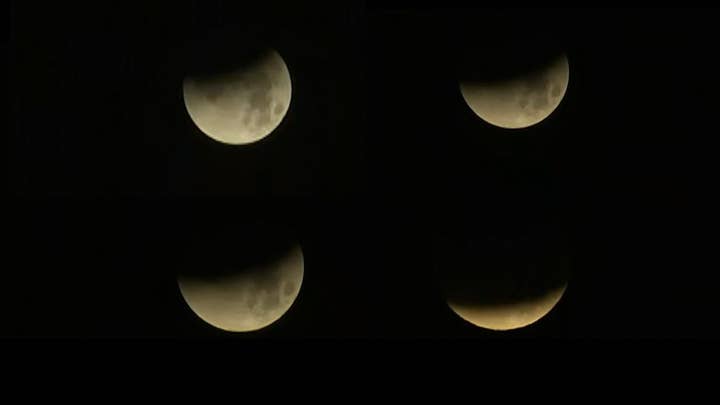
Earth will experience a rare 'super blood moon' eclipse on Jan. 20 and Jan. 21. (AP Photo/Richard Vogel)
Stargazers will witness a trifecta of lunar events in the New Year — a total lunar eclipse, a super blood Moon and a "Wolf Moon," a nickname for a full Moon that appears in the middle of winter.
Millions of people across North and South America and portions of western Europe and Africa will be able to catch the rare sight overnight on January 20 into January 21, according to National Geographic. For a few hours, the moon will give off a bright reddish glow.
"A total lunar eclipse can happen only when the Sun, Earth and Moon are perfectly lined up — anything less than perfection creates a partial lunar eclipse or no eclipse at all," Space.com explains.
You won't want to miss it. Earth won't experience another total lunar eclipse, which occurs when the entire Moon enters Earth’s shadow, until May 2021, NASA estimates.
MYSTERIOUS 'CREATURE' SPOTTED IN JUPITER'S CLOUDS STUNS NASA, SPACE ENTHUSIASTS
Here's everything you need to know about the unusual phenomenon.
When can I see the 2019 total lunar eclipse?
The 2019 total lunar eclipse will last approximately 1 hour and 2 minutes, Space.com reports. It will kick off around 11:41 p.m. ET on Jan. 20 and peak around 12:16 a.m. ET on Jan. 21.
The longest possible lunar eclipse is 1 hour and 47 minutes, according to EarthSky. The longest total lunar eclipse of the last century was on July 16, 2000, and lasted for 1 hour and 46.4 minutes, the space site notes.
The last total lunar eclipse took place on July 27, though it wasn't visible in the U.S.
What is a "super blood moon"?
A supermoon is a new or full moon that appears closer than usual because it’s the closest distance the moon gets to Earth during its orbit, known as "perigee" located about 363,000 kilometers from Earth, NASA says.
Supermoons typically appear 14 percent larger and 30 percent brighter than the average moon seen in the sky each night, Dr. Noah Petro, a research scientist from NASA’s Goddard Space Flight Center, previously told Fox News. However, it's hard to really spot the difference with the naked eye.
"That's not enough to notice unless you're a very careful moon-watcher," Sky & Telescope magazine senior editor Alan MacRobert told Space.com in 2016.
The term "blood" stems from the rusty brownish-red color the Moon turns during a total lunar eclipse.
"That's because some of the sunlight going through Earth's atmosphere is bent around the edge of our planet and falls onto the moon's surface. Earth's air also scatters more shorter-wavelength light (in colors such as green or blue); what's left is the longer-wavelength, redder end of the spectrum," Space.com states on its website.
What is a "wolf moon"?
The January full moon was nicknamed the "wolf Moon" — and occasionally the "Old Moon" — by Native American tribes after wolves that howled outside as they hunted for food in mid-winter.
"This is an age-old practice, nothing new. Ancient peoples commonly tracked the seasons by following the lunar calendar (versus today’s solar calendar)," The Old Farmer’s Almanac explains in a post online.
Fox News' James Rogers and Nicole Darrah contributed to this report.





















